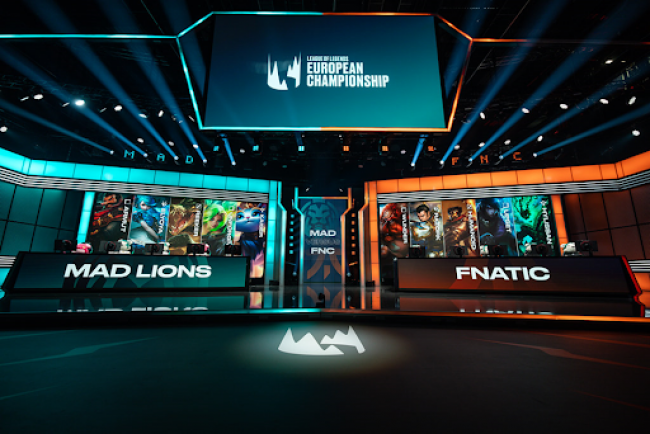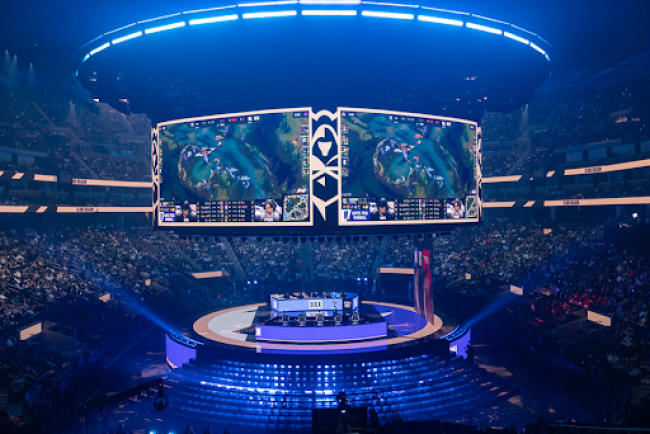“Where were you when the West rose?”
Europe’s first real taste of international victory since the game’s inception was a sentiment that spurred the region. Three of the eight quarterfinalists in the 2019 World Championship came from the League of Legends European Championship (LEC), and G2 Esports made a historic run to the world finals. But Europe did not reach these heights again, and indeed, in the 2022 World Championship, Rogue – the only European team to even qualify for the quarterfinals – was sent home 3-0 by League of Legends Pro League ‘s (LPL) JD Gaming (JDG).
So why is it that with competitive League of Legends on the rise worldwide, European League of Legends is declining, and what can be done to stop it? With its revamped 2023 format and EMEA changes, the LEC seeks to answer that question.
For those who don’t know, the LEC (formerly the League of Legends European Championship) has been renamed the League of Legends Europe, Middle East and Africa (EMEA) Championship – still the LEC for short – ready for 2023.
The LEC is changing from a two-split system to a three-split system, with more high-stakes games, as well as best-of-three and best-of-five matches being included more frequently in the championship, in an effort to increase the region’s competitiveness.
With this rebranding also comes a change in service areas accredited by Riot Games. Amid the expansion of the league, however, the Northern League of Legends Championship (NLC) is remarkably no longer an accredited region.
Of the 50 key selection players scheduled to play in the LEC in 2023, 16 are from and/or have played in the NLC or its regions during their careers, especially as they rise through Europe’s competitive League of Legends scene.
Therefore, nearly a third of the LEC has been contributed in one way or another by the northern region overall, including standouts such as Carl Martin Erik “Rekkles” Larsson, Rasmus “Caps” Borregaard Winther and Martin “Wunder” Nordahl Hansen. In addition, notable 2023 LEC rookies like Kim “Chasy” Dong-hyeon and Martin “Yike” Sundelin follow, proving that the NLC is still invaluable as a piece of Europe’s talent-producing puzzle.
Therefore, it may seem an odd decision to cut funding to such a crucial region at a time when European League of Legends is struggling. Most popular during the summer split, the LEC dropped from a peak viewership of 1,002,178 and an average viewership of 301,165 in 2020 to a peak viewership of 732,573 and an average viewership of 211,743 in 2022.
On the other hand, the number of NLC viewers has been on the rise over the past two years. Also most popular during the Summer Split, the NLC has increased from a peak viewership of 9,925 and an average viewership of 1,860 to a peak viewership of 14,023 and an average viewership of 3,822 in 2022. Because the NLC is no longer accredited, however, it is a pipeline that could suffer tremendously in the future, and this could be the beginning of a worrisome trend in Europe’s ability to produce talent.
For example, X7 Esports, the organization from which Chasy just joined MAD Lions, is shutting down. A major NLC competitor, ranked first in the spring and second in the summer, the changes in the region’s accreditation mean they can no longer continue to operate, and so their skill in producing and integrating talent in Europe has been lost.
In a public statement, Josh Kingett, founder and CEO of X7 Esports, said:
“Our intention in 2022 was to raise capital and continue our growth into 2023, but X7 was hit this year – like many other companies – by a series of unforeseen global circumstances.
“However, due to the recent changes Riot Games made to European Regional Leagues (ERLs) for 2023, in conjunction with our regional TO, Freaks 4U Gaming, it was announced that the NLC will be downgraded to non-accredited status, including severe cuts. The domino effect has a profound impact on our projected revenue in the future, devalues the assets we own and ends the business model we have implemented to provide sustainability for the company.”
It is important to note, as Kingett does, that a host of unforeseen and unfortunate circumstances have contributed to an economic downturn, but the NLC’s loss of accreditation has exacerbated an already dire situation.
As with X7, many teams are looking internationally for talent in these times.
Kingett said: “Having noticed a steady demand for imported talent in both the LEC / LCS, our goal with X7 and its League of Legends project was to provide a platform to promote world-class players from East Asia and help them integrate into Western teams.
“We have achieved demonstrable success with this business model and are proud to have worked with and handed over to Kang “Haru” Min-seung and Kim “Chasy” Dong-hyeon to Team Vitality and MAD Lions to the LEC, respectively.”
Perhaps what we see in the collapse of X7 is a potential future of the LEC if it relies too heavily on imported talent and continues to neglect ERLs. Yet imports into the LEC continue to rise, from just two in 2021 to seven in 2023, including players like Kim “Malrang” Geun-seong who has made a name for himself in the LEC, plus new talent and regional standouts like Shunsuke “Evi” Murase.
Anne Banschbach, Esports Director at Team Vitality, sees a different reality. Team Vitality has imported top laner Kyeong “Photon” Gyu-tae from the T1 Challengers From the LCK Challengers League and jungler Zhou “Bo” Yang-Bo from the LPL’s FunPlus Phoenix for the new season.
With both players set to debut in Team Vitality’s 2023 starting squad, Team Vitality sees the new format changes and importing players as an opportunity to increase Europe’s competitiveness, and thus the caliber of its up-and-coming talent.
Banschbach told us: “We and the players are excited about the new format in 2023. Having more officials during the regular season and a chance to play more BO3s and BO5s is what we have wanted for a long time. More officials means more stage experience. After all, best practice is actual competition.”
About their selection, Banschbach said: “Team Vitality’s primary ambition has always been to identify, develop and celebrate new talent. Our focus in recent years has increasingly been on making solid scouting decisions with more informed insights. That combined with the respective great opportunities around these international talents, we went for it.
“Building a team around Bo and Perkz was the goal for 2023. Photon was just the perfect mix of playing style, character and availability that we could pick up.
“Performance is in our DNA, we want to be successful on LEC and international stages. So we chose an experienced core with experienced LEC players and promising talents who have not yet had the chance to show their full range.
“Further talent development is the reason why we continue to operate our LFL Academy team and where we focus on rookies with great potential to become a future star and starter in the LEC.”
Banschbach signed off with: “We believe the new format has the potential to not only have a positive impact on the international status of the LEC, but also make room for new talent from Europe. Having international talent in the LEC will challenge the rest of the European scene to adapt and improve to stay competitive, which will only strengthen the scene in the long run.”
Similarly, frequent NLC and LEC caster Alex “Nymaera” Hapgood believes EMEA changes and importing players will inject life into a rapidly stagnant region – both in the case of the LEC and NLC.
Nymaera told us: “It is very difficult to overlook up-and-coming Korean talent.
“The actual organizations and development of players (in Europe) is far, far behind Korea.
“Is it easier to integrate someone from a foreign culture with Second Language English speaking skills, or teach someone a higher level League of Legends to the highest degree, so they would be on equal footing?”
There seems to be a shortage of experience and talent in Europe as a whole. This makes it difficult for teams – which are at their core businesses – to justify the significantly higher financial cost of long-term investments in ERL-grown talent that may not pay off.
Instead, importing cheaper, highly skilled players and investing in reliable integration systems seems to be the path many want to take.
As a franchise league, teams in the LEC have often been able to coast during splits and tolerate underperformance. During earlier knockouts, the pressure to perform increases.
Nymaera said: “You have the fear of irrelevance to a much higher degree than you have had before.
“What you essentially have is fear of degradation without actually being degraded.
“I think it will affect the bottom of the league in a positive way, just by sheer fear of having to improve.”
Of course, Nymaera argues, less screen time means less brand representation for organizations’ partners, and so they are forced to push for performance like never before because it directly affects their revenue streams.
This pressure extends to ERLs as well. In a region that he says is already suffering from a “non-intuitive” collective marketing identity, the economics of the NLC’s pipeline business model seem to have dried up.
He added: “Now you have very important and influential players, staff and teams withdrawing from the league.
“You lose a base of skills that are hard to replace at the ERL level.
“It leads to a new period of instability, it leads to a different kind of emotionally difficult situation for a lot of people dealing with it, and for new people coming in, in all levels of the industry, there are fewer skills to train yourself with – it’s a less prominent environment to be a talent pipeline for bigger things – which is what the NLC positions itself to be.”
Increasing pressure can lead to diamonds in the rough, however, and Nymaera sees paths for improvement and innovation across the board in European League of Legends.
“Perhaps there is room for expansion (in LEC franchising) in the future, or for more resources to be put into the European Masters circuit,” Thus Nymaera.
“Maybe in best-of-three games you can think about how invaders work in the LEC.”
Looking at the NLC, Nymaera concluded: “Maybe it would be better to be able to grow organically from that point.
“We’re in the dirt – let’s go make something of it.”
Either way, it will be an interesting and unprecedented year for European League of Legends. But will it be the beginning of a new golden era, or the final nail in the coffin? We’ll see when the LEC kicks off on Jan. 21 for 2023, followed by the NLC on Jan. 24.
What are your thoughts on the future of the LEC and NLC? Which teams are you most looking forward to this year? Let us know below.







 2024 BAFTA Games Awards: all categories and nominees -.
2024 BAFTA Games Awards: all categories and nominees -. Everything you need to know about Amazon’s Fallout ahead of release: we talked to the creators – Fallout (Amazon)
Everything you need to know about Amazon’s Fallout ahead of release: we talked to the creators – Fallout (Amazon) 10 hidden gems on Apple Arcade –
10 hidden gems on Apple Arcade – Oscars 2024: all categories and winners –
Oscars 2024: all categories and winners – Netflix: what to watch in March 2024 –
Netflix: what to watch in March 2024 –